Table of contents
What would you do if your CEO came to you tomorrow and wanted you to increase sales by $25,000 next month?
Would you already have a rough idea of the work to hit this number (even if it would be super hard)?
Or, would you immediately freak out, encourage your sales reps to start pounding the phones even more, and pray for a miracle?
Tracking your sales activity properly in HubSpot CRM can help you plan and forecast your weekly, monthly, and even annual sales effectively.
So going back to our $25,000 example, if you use a sales activity tracker, you can work out roughly how many emails your team needs to send, calls made, and sales demos conducted in order to have a good chance of hitting this goal.
In this post, we’re sharing 23 tips to help you effectively track sales activity within HubSpot, including:
- Don’t lose sight of the big picture
- Analyze the number of leads contacted to sales made
- Track repeat purchases and total revenue for each customer
- Map out all of your different client journeys
- Define your life cycle and deal stages properly
- Set up detailed deal workflows
- Keep lead statuses up-to-date
- Create custom call and meeting types
- Use the mobile app
- Track when emails are opened, clicked and replied to
- Track sales email, not all email activity
- Use HubSpot’s Sales Team Productivity Tool
- Create a sales productivity dashboard
- Create custom tags
- Monitor the original lead source
- Implement HubSpot’s tracking links
- Segment sales qualified leads (SQLs) by lead status
- Use Hubspot score to qualify leads
- Get the reporting add-on
- Customize your main HubSpot dashboard
- Focus on the number of meetings conducted
- Be consistent with your approach
- Send an automated satisfaction survey

What are the primary metrics sales teams are tracking in HubSpot CRM?
The average company we surveyed had 2-3 salespeople using HubSpot CRM to track sales activity.
The most common things sales teams were tracking include:
- Deals Closed Won
- Deals Created
- Closed Won Amount N
- Number of Meetings
- Number of Emails Sent
- Number of Calls Made
1. Don’t lose sight of the big picture
“Be sure to track the actual sales,” says Andrea Loubier of Mailbird. “Sometimes, we get so caught up in email responses, leads, and other activities, that we forget to keep our eye on the bottom line. Sure, it’s great to see a spike in email responses, but they must convert to sales to really label it as a win.”
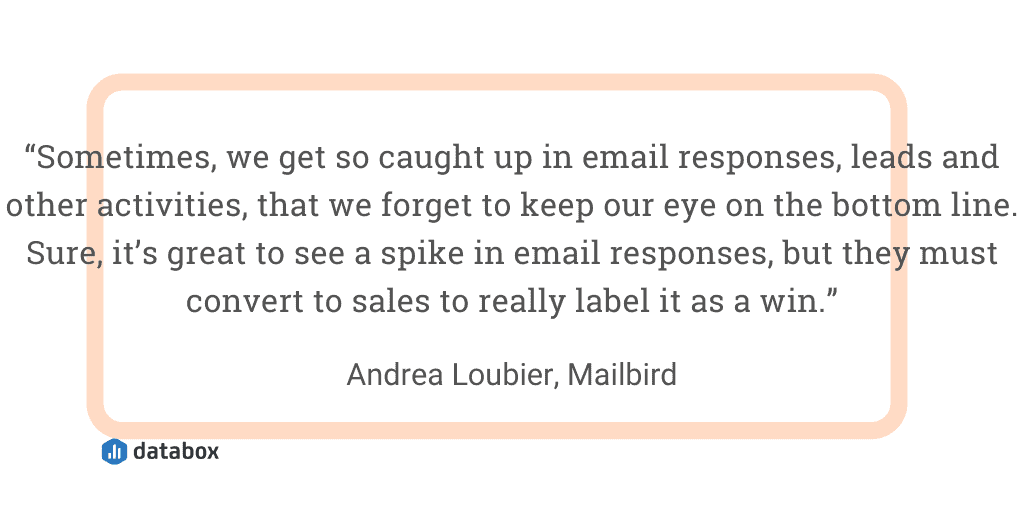
Editor’s Note: Use this HubSpot CRM dashboard template to get a big picture snapshot of insights into the sales pipelines and new deals.
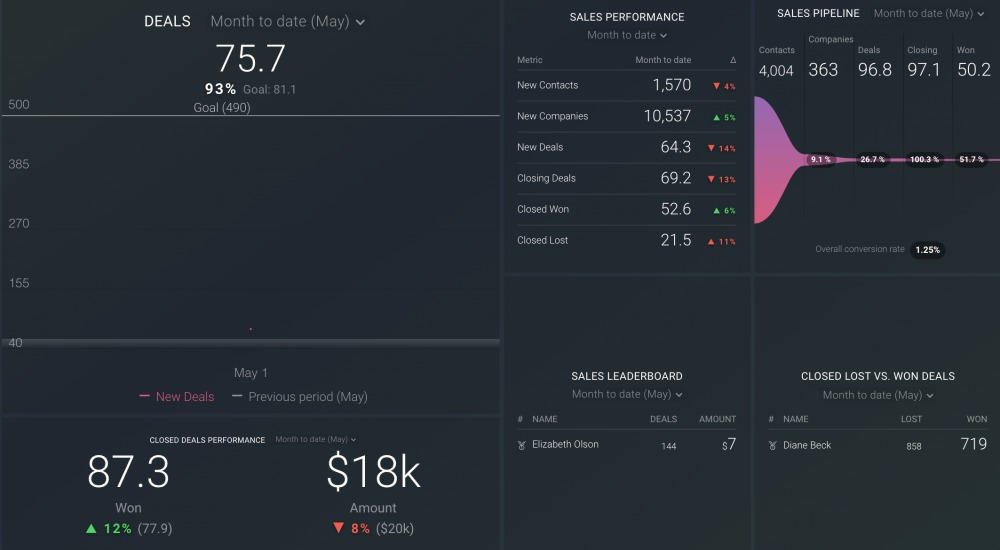
2. Analyze the number of leads contacted to sales made
“When setting up the Hubspot CRM, you don’t want to stop at lead generation or lead scoring,” says Jonathan Aufray of Growth Hackers Company. “What you want to do is make sales and close deals. To track your sales activity, I recommend you analyze the ratio number of sales / number of leads contacted. This will show you the percentage of closed leads and show you how targeted and qualified your lead generation channels are.
3. Track repeat purchases and total revenue for each customer
“Tracking sales in the HubSpot CRM is great, but we personally really enjoy the ability to see repeat buys and total customer sales and revenue from each client,” says Ken Christensen of Christensen Recycling. “This provides an extra layer of stats that we can analyze. Then, see what demographics and traffic sources work best for long term ROI and repeat buyers.”
4. Map out all of your different client journeys
“The most effective way to track sales activity, for our company, has been to begin by creating a map or a flowchart of the different client journeys from prospective to closed,” says Eli Nupanga of Mars Hill Marketing. ”We create stages and factors that will qualify the prospective client to graduate to the next level. Each stage has a specific call-to-action. We also track friction between stages to ensure that we have answers to commonly asked questions.
Using a map or flowchart, we are able to optimize and scale our processes. It also helps us to document each stage. The flowchart is very detailed and captures how we handle new leads, where the information is stored, when we offer a potential client a proposal and the different people involved in the sales journey.”
Alejandro Rioja adds, “The most common mistake I see businesses making is to set up HubSpot as they go with no clear implementation goals. Any type of software transition is challenging, especially when it’s as robust as HubSpot, but you need to make sure to think through how you are going to monitor the sales process and especially who is going to use the software.”
Stacey Lund of Reversevision agrees, “Know your sales goals going into your implementation and use the goals section of HubSpot to track them.”
5. Define your life cycle and deal stages properly
“Above all, you should properly define and set up Life Cycle Stages and Deal Stages & Properties to track your sales activities effectively and conveniently,” says Hleb Myrko of RGray. “They should be perfectly aligned with sales and marketing processes & funnel within your company. In this way, you’ll prevent misunderstanding among your team members (both marketing and sales) and the mess in analytics. It’s extremely important to approve Life Cycle Stages and Deal Stages & Properties selected with your team (people who will work by these rules) to make it looks clear, logical and convenient for them => they will always have the motivation to fill the data properly to track their personal results.”
David LaVine of RocLogic Marketing adds, “Be sure to take the time to define and refine your deal stages in HubSpot’s CRM. You want your stages to reflect your sales reality. If your sales process is complex, don’t try to oversimplify the reality away. Otherwise, you may lose important information and patterns that emerge that show trip points. If a ton of deals start piling up in one stage, this may be an indicator that you need to change your behavior and/or refine your stages. Proper deal stage configuration can also help highlight which deals are worth trying to re-engage, and when.”
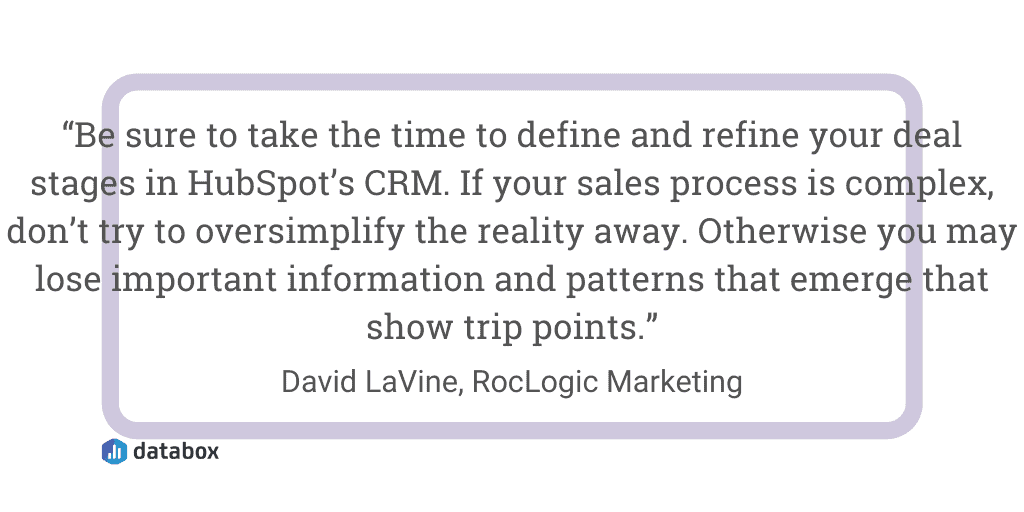
6. Set up detailed deal workflows
Gabriel Richards of Endertech says “Set up your Deal Board workflow, document new deal amounts diligently (to get good pipeline reports), work all deals through each stage of the workflow (to get good funnel reports), and have a weekly review meeting with your team to keep all sales staff in sync and accountable.”
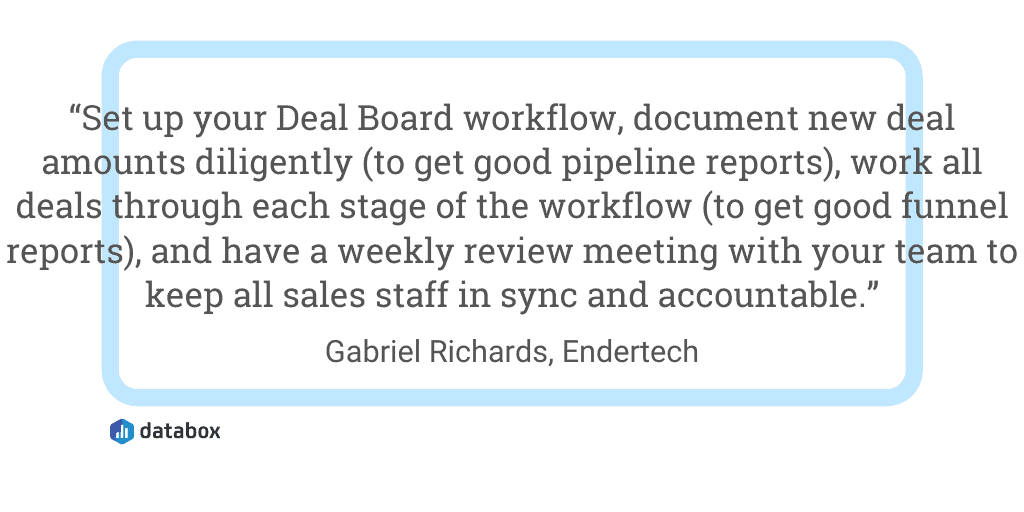
For example, Obaid Khan of Planet Content says, “I always use the deal board to keep deals up-to-date and the deal forecast to prioritize my deals. It helps me keep track of sales activity for all deals.”
Anastasia Iliou of Rain adds, “Take advantage of the workflows feature. Use workflows to assign certain lead statuses based on activity. For example, you could create a Lead Status contact property and add fields for engaged and disengaged. Then, create a workflow that automatically sets the property to engaged when the contact clicks on links in your emails. Seemingly small steps like this can really help you and your sales team identify hot leads vs. cold leads and help you narrow down your focus.”
Brandon Amoroso of electrIQ marketing recommends, “Setting up workflows so that you can get notified of sales activity that would indicate a hot lead. We have a workflow setup that automatically pings me if someone has viewed our free consultation page but did not convert.”
Check out these free business development dashboard examples for tracking your potential buyers as they move from one sales stage to the next.
7. Keep lead statuses up-to-date
“Keep your lead status updated,” says Steve King of Adventure World Play Sets. “The more leads you enter into the database, the more difficult it will become to keep track. Track every stage of the sales process with notes about your prospect and your conversations. This will allow you to engage with them more effectively every step of the way.”
Joe Robison of Green Flag Digital adds, “Make sure your lead status/stages align with your own process. HubSpot has a built-in lead status, but with my teams, I often create a custom lead stage to track leads before they’re ready for a deal to be created. This allows for more granular filtering and tracking when you have a lot of leads to keep track of.”
Check out these free sales leads dashboard examples.
8. Create custom call and meeting types
“My top tip for those trying to track sales activities is to create different custom call and meeting types,” says Rachel Foley of Map My Customers. “This way, you have a better idea of what types of interactions your sales reps are having with prospects — not just generic notes.”
Browse through these free call tracking dashboard examples here.
9. Use the mobile app
“Use the app,” says Ashley Hill of ashleyidesign. “HubSpot’s CRM phone app is great for updating contacts and deals on the fly right after meetings/calls.”
10. Track when emails are opened, clicked and replied to
“Email responses are very important when you’ve implemented an email marketing or outreach campaign,” says Alezandra Zamolo of Beekeeper. “In these times, so much groundwork is being laid via email, as well as the actual closing of deals. That’s why tracking this can let you see how successful your efforts are across the board.”
Daniel Lynch of Empathy First Media says, “As a sales rep, it is our job to take inbound leads and create conversations, as well as maintain those conversations until a deal is closed. When talking to prospects and sending emails with the sequence tools, check your notifications to see how often the leads are opening your email. I have found that a qualified lead will open the email a few times, so if you see that and they do not engage you, it may be time to pick up the phone and try to right hook them with a phone call.”
Oana Borcoman of EVOKE Experiences adds, “My favorite way to use HubSpot CRM is through the email logging and tracking tool for cold emails to prospects. It is my secret tool in seeing not only if they opened it, but also how many times they opened it, if they responded after opening, and if they forwarded it to someone else (if I see an open on the email from an unknown reader). For the ultimate tracking, I compare the time they opened my email with checking my website tracking tools to see how they interacted with my website (if they clicked on a link in the email). I can view a recording of what pages they spent the most time on and what they clicked. This allows my next conversation to be very tailored to what I already know interests them, and the HubSpot email tracking pinpoints their email read time to a website interaction and IP address.
On the other hand, if I do not see an open, I resend emails or do more aggressive follow-ups as I do not feel like I am badgering them but rather that my initial email went unnoticed. HubSpot intel allows me to tailor my communications for cold outreach much better to each prospect.”
Melanie Musson of AutoInsuranceCompanies.com recommends taking this further.
“Track the moment an email attachment is opened in real-time,” says Musson. “That way you can respond appropriately with a follow-up point of contact. When they interact with an email by opening up an attachment, they’re taking a step towards conversion. Another email offering an incentive or encouragement may be what’s needed to go another step forward toward conversion.”
11. Track sales email, not all email activity
“Be sure you and your team are tracking *sales* emails and not all email activity,” says Julie Ewald of Impressa Solutions LLC. “We’ve had to clean up many HubSpot portals where clients were paying for a lot of contacts that weren’t going to be prospects in a million years. Default logging and tracking pulled in vendors, colleagues, job candidates, salespeople, spammers, family members, their kids’ coaches, and just about everyone under the sun into their contact list. Beyond cost, these messy lists could lead to deliverability issues if HubSpot is then used to send marketing emails to this hodgepodge list of irrelevant folks.”
12. Use HubSpot’s Sales Team Productivity Tool
“I love using the Sales Team Productivity tool to generate reports that track sales activity from a high-level,” says Stephanie Riel of RielDeal Marketing. “Meetings, calls and email are great activity markers, but my top tip is that it is important to educate and empower your entire team on the value of using HubSpot for all engagements so all the data is logged properly.”
13. Create a sales productivity dashboard
“As a HubSpot solutions provider, we get asked about tracking sales activity all the time, and generally speaking we find it most impactful when clients set up a Productivity Dashboard,” says Spencer Smith of IRC Sales Solutions. “This tracks the top 5 metrics that mean the most to your team in terms of productivity, and allows you to view them all in one very convenient, easy to find dashboard. These are customizable but by default, these are metrics such as number of emails sent to contacts, meetings, calls, notes, and tasks.”
Editor’s Note: Use this HubSpot Weekly Sales Activity Dashboard to manage all of the day-to-day metrics, including emails, calls, and meetings.
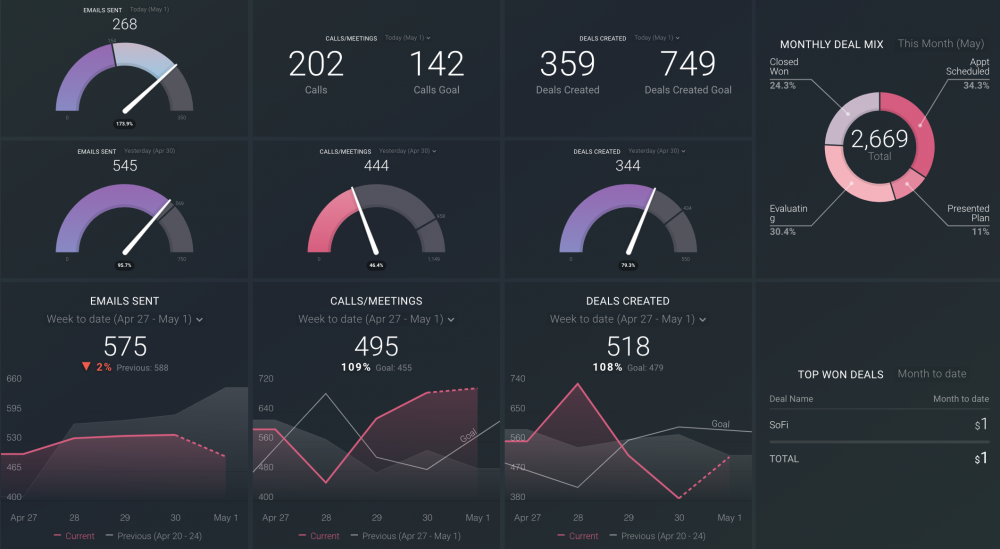
14. Create custom tags
“Create a custom contact property labeled tags,” says Nathan Bliss of Kinsta. “The field type can be a simple single-line text, but from that, you can create different tags for contacts so you can track and organize your leads more intelligently. It is a great way to ensure your activity stays high on your very best lead types.”
15. Monitor the original lead source
“In the deal object, I always make sure to create and set up custom lead source tracking properties based on the original lead source of the lead contact,” says Drew Beechler of High Alpha. “This ensures that you can accurately track and report on opportunity/deal lead source to have full-funnel marketing attribution.”
16. Implement HubSpot’s tracking links
“One of the best ways to improve lead tracking is to implement HubSpot tracking links in all of your campaigns,” says Sarah Petrova of Techtestreport. “By doing so you can measure and determine exactly how successful a campaign was. Whether it was through banner ads, landing pages, or other lead generation sources.
What gets measured gets improved, and by A/B testing different campaign strategies you can actually improve primary conversion metrics, like percentage of opportunities closed/won, or Percentage of opportunities won by lead source.”
For example, Harpreet Munjal of DotComOnly says, “If we publish a sponsored post at a publication, then we’ll tag and track our links properly with trackable codes. When someone becomes our lead through these links, Hubspot cookies will track that and store the information in the marketing database. Then we know that leads come from our sponsored content.
These tracked codes will remain with the lead in Hubspot sales tool. And from that, we can get all the information about the deal size and other insights. So we can compare the total investment with the return to find the ROI from that sponsored content.”
17. Segment sales qualified leads (SQLs) by lead status
“You HAVE to use lead status in HubSpot to segment your SQLs,” says Thorstein Nordby of Nettly. “Most companies are aware of lifecycle stages, but many do not use lead status to segment their SQLs. Lead status is a feature that will open many opportunities to automate your sales process and ensure that every sales qualified lead is being followed up properly.
With lead status, you can categorize SQLs into different statuses like New, In progress, or Open opportunity. You can then easily create a task queue for your sales reps that shows them which SQLs they need to focus on first. It will also give them more context around each lead, as an SQL tagged as New needs to be managed differently than an SQL that they have followed up with for a long time.”
18. Use Hubspot score to qualify leads
“Taking advantage of HubSpot score,” says Yaniv Goldenberg of cnvrg.io. “We’ve built a precise model with 30+ different factors, we are taking into account both positive and negative actions.
The score allows us to rank (and track) better sales opportunities along the funnel, align marketing & sales, and shorten the sales cycle.”
19. Get the reporting add-on
While 55.3% of the people we surveyed think HubSpot’s free CRM is superior to alternatives, there are many reasons why it might be smart to upgrade to a paid version. Most notably, this is for better reporting capabilities.
“Get the reporting upgrade,” says Ablorde Ashigbi of 4Degrees. “It’s worth it to be able to visualize your activity in a way that makes sense for your own business and efficiency.”
Nicole Turner of Chief Martech Officer adds, “The best way to track sales activity with the HubSpot CRM is with reports. You can start with these default ones and then build custom reports depending on your goals.
~Team activities by activity date
~Contacts created and worked totals with deals created and won totals
~Deal revenue forecast by stages
~Deal closed totals vs goal
~Team activity totals.”
20. Customize your main HubSpot dashboard
“Customize your sales dashboard and set it up to deliver it to your inbox daily,” says Lori O’Connor of Leighton Interactive. “This keeps my biggest priority top of mind.”
21. Focus on the number of meetings conducted
“Not all activity is equal in sales,” says Claudio Pereira of Uku Inbound. “Most sales managers will tell you that reaching a target is a numbers game. Hit your daily numbers and you’ll hit your monthly or quarterly revenue target in no time.
This can depend on industries and business models, but the sales metric we focus on the most in HubSpot’s CRM is meetings held.
Having a meeting with a sales qualified lead increases their probability of closing significantly, so a lot of our efforts internally are around getting meetings booked.
HubSpot helps a lot with some of the CRM’s features for meetings. Firstly being able to connect your Gmail or Outlook 365 account to HubSpot means reporting and tracking meetings is seamless, plus the online booking features HubSpot has made available means it’s even easier for our leads to book time with us.”
22. Be consistent with your approach
Tyler Pigott of Lone Fir Creative says, “Using the tool consistently to track all your comms with prospects, notes, estimates, etc. So, it becomes a routine for the sales team.”
23. Send an automated satisfaction survey
“Follow through doesn’t end when you close the deal,” says Nicole Mertes of Weidert Group.”Activate an automated HubSpot satisfaction survey to learn about your buyers’ experience after the deal is Closed Won or Closed Lost. Apply what you learn to continuously improve your sales process for the buyer and even turn them into promoters of your brand!”
In sum, when you are effectively tracking sales activity, you can better manage your sales team, ensure that everyone is hitting quota, and set up more accurate sales forecasts.
Additionally, use these free CRM dashboard examples from our sales dashboard software to monitor and manage your sales activity and KPIs, goals, leads, and their current stages.















